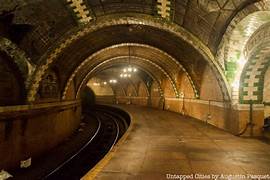On October 27, 1904, the city of New York celebrated a monumental achievement in urban transportation with the opening of the New York City Subway. The subway system, which remains a vital part of the city's infrastructure to this day, revolutionized the way people traveled and transformed the landscape of New York City. The New York City Subway was the first underground rapid transit system in the United States and one of the earliest in the world. Its construction was a response to the growing population and congestion in New York City, as well as the need for a more efficient mode of transportation. The subway system aimed to alleviate traffic congestion on the streets and provide a reliable and accessible means of transportation for the city's residents. The inaugural day of the subway marked a significant moment in the city's history. Thousands of New Yorkers lined up to experience the novelty of underground travel. The subway's first line, known as the Interborough Rapid Transit (IRT), consisted of a 9.1-mile track running from City Hall in Manhattan to 145th Street in Harlem. The opening day saw great excitement as people marveled at the convenience and speed of this new mode of transportation. The New York City Subway system quickly became a vital lifeline for the city's residents, connecting neighborhoods and enabling easy access to various parts of the city. It played a crucial role in the development and expansion of New York City, allowing for the growth of residential areas and the establishment of new business districts. The subway became an integral part of the city's identity and a symbol of its vitality and progress. The success of the New York City Subway system prompted further expansion and the construction of additional subway lines. Over the years, the subway network expanded to cover extensive areas of the city, connecting all five boroughs and serving millions of passengers each day. Today, the New York City Subway is one of the largest and busiest subway systems in the world, with over 400 stations and more than 600 miles of track. The subway system's impact extended beyond transportation. It influenced the city's culture, economy, and social fabric. The subway became a melting pot, bringing together people from diverse backgrounds and fostering a sense of shared experience and community. It provided access to cultural institutions, employment opportunities, and educational institutions, making it an essential lifeline for New Yorkers from all walks of life. However, the subway system has faced challenges over the years. Aging infrastructure, overcrowding, and delays have been ongoing issues that the city has continually worked to address. Nonetheless, the New York City Subway remains an integral part of the city's identity and continues to be a vital mode of transportation for millions of residents and visitors alike.
27 Oct, 1904 New York Subway
